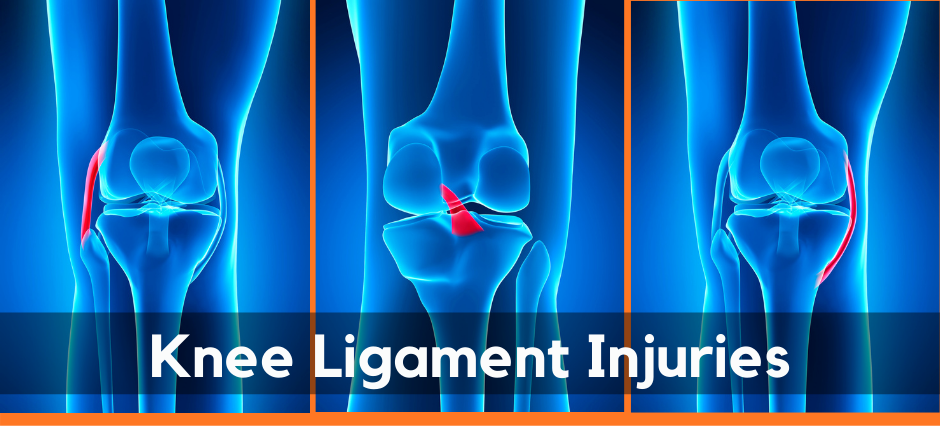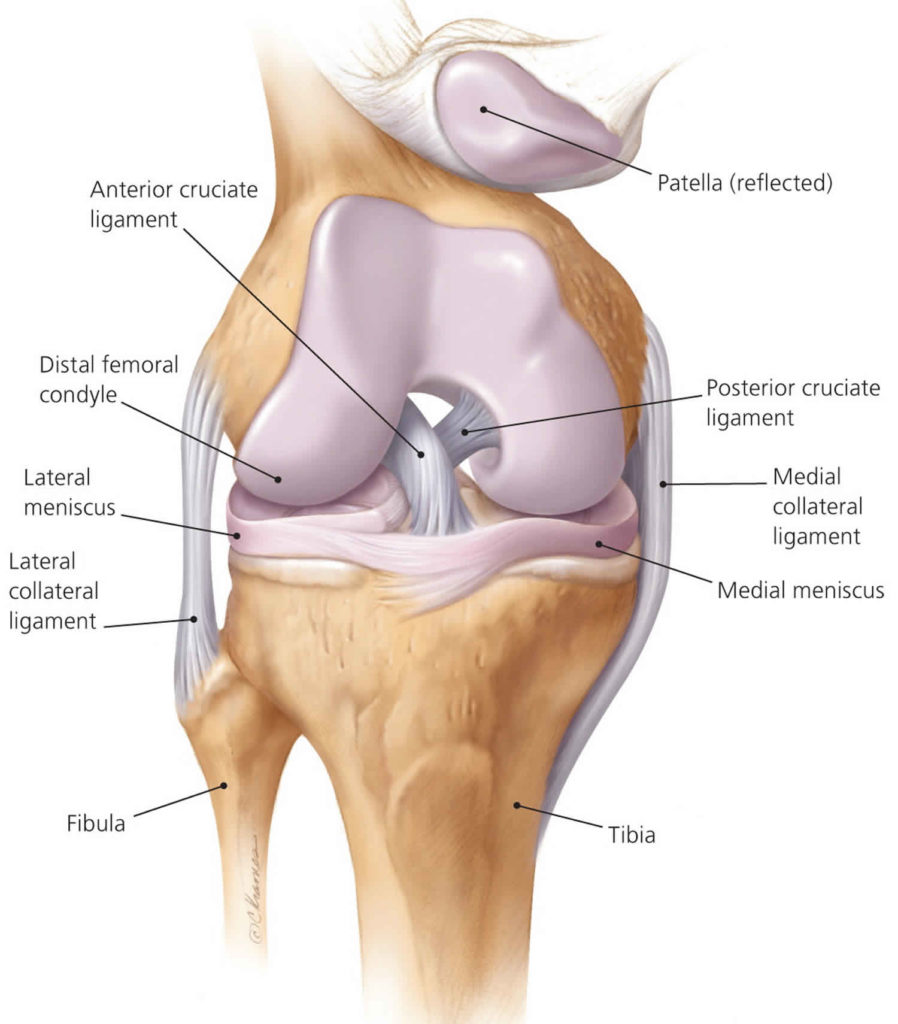
There are many ligaments within and around your knee joint that work together to help keep it stable and functioning well. The four main ligaments – and the ones commonly injured – include the two cruciate ligaments and the two collateral ligaments.
 Cruciate Ligaments
Cruciate Ligaments
There are two cruciate ligaments called the anterior cruciate ligament (ACL) and the posterior cruciate ligament (PCL). These ligaments are located within the knee joint, connecting to both the bottom of the thigh bone and the top of the shin bone, where the bone ends connect at the joint. The two ligaments cross diagonally inside the knee to stop the two bones sliding backwards or forwards on one another. This means during walking, the thigh bone doesn’t just slide forwards on the shin bone, for example.
Collateral Ligaments
There are two collateral ligaments called the medial collateral ligament (MCL) and the lateral collateral ligament (LCL). These flat-banded ligaments are located on the outside of the knee joint at either side, connecting to both thigh and shin bones. These ligaments work to prevent excessive side-to-side movement that would otherwise lead to significant joint damage and dislocation.
Ligament Injury Symptoms & Causes
When excessive force is applied to these ligaments, this causes them to become strained and damaged, meaning they can no longer perform their function effectively until they have a chance to properly heal and repair.
Any sudden force or impact is a common cause of injury to the knee ligaments, such as from a soccer ball hitting the outside of your knee joint at high speed, or being tackled and having your body thrust forwards or backwards while your foot is firmly planted on the ground.
Aside from causing significant pain, ligament injury will often cause your knee to feel weak and unstable, and may result in stiffness or swelling, making it difficult for you to walk or bend the knee.
Treating A Knee Ligament Injury
Treating ligament damage needs an aggressive approach, not a ‘wait and see’ method to allow the ligaments to heal well and in the shortest amount of time, without causing further damage or causing the ligament to rupture. Your podiatrist will discuss with you the best options based on the severity of the current damage and your current symptoms. Your care may include using a brace, offloading pressure from the knee joint with orthotics (if alignment issues are causing strain on the ligaments), using supportive and stabilising footwear, and then introducing a strengthening, flexibility and knee mobility program.
FAQ’s
How can I tell which knee ligament has been injured?
If you’re experiencing knee pain, then the first thing to acknowledge is that the cause of your pain may not be an injured ligament – it may be a tendon, bone, the cartilage in the joint capsule and several other mechanisms of injury. This is why it’s important to have it looked at by a podiatrist, who may also refer you for medical imaging to get a definitive diagnosis of which tissues have been injured, as multiple tissues are often injured at once.
If it is a ligament, the best way to take an educated guess about which knee ligament you have injured is looking at how the injury occurred. If a soccer ball hits you on the outside of the knee, then it is likely that the ligament on the inside of the knee may be damaged as a result of the reverberating effect – and vice versa. If the tibia (shin bone) moves forward relative to the femur, it is the anterior cruciate ligament (ACL) that is likely damaged, and the posterior cruciate ligament helps keep the shin bone from moving too far backwards – so if you see that the shins are thrust backwards relative to the femur, it is the PCL that is likely injured.
Should I pause all sports if I have knee pain?
In the acute stages, after a notable injury, it is best to pause any activities that aggravate your knee pain, which are often related to sports. Beyond the acute stage, it all depends on the severity of your injury and your treatment plan. Your podiatrist will discuss this with you including continuing physical activity with some possible modifications.
Why have I developed foot pain after my knee pain?
When you have knee pain, you may change the way you walk in order to protect the sore knee and minimise your pain. As a result, you may load your feet suboptimally, which can result in pain.
Is knee pain easy to fix?
This depends entirely on the kind of injury you have, the severity of your injury, and how closely you stick to your treatment plan. Our podiatrists will always aim to optimise your recovery as quickly and easily as possible.
Should I be strapping my knee?
Knee strapping can be an effective way to help stabilise the knee, especially when one or more of the ligaments have been damaged and cannot carry out their stabilising functions as effectively. If it can help you, we can show you exactly how you should be strapping your knee so you can replicate the technique at home as needed. If you’re wanting a general knee strap, here are two video examples from KT Tape and Elastoplast.
Does knee pain require surgery?
In most cases, knee pain does not require surgery. Surgery is also an invasive treatment with a significant recovery time, hence it is not typically considered a ‘first line’ treatment when there are plenty of conservative options available, like strapping, bracing, rehab exercises and activity modification, that can help effectively heal the injury.
Can knee pain ever truly go away or will I always have a mild dull ache or discomfort?
Knee pain can absolutely go away completely in most cases of ligament injuries. Your pain is only produced by the stress on injured tissues and ligaments, so once we can help these injured areas recover, and help rehabilitate the area back to full strength and function, there is no reason that your pain should continue to linger. As podiatrists, we do everything we can to help you move freely and without pain for the years to come.
Can orthotics help knee pain?
In some cases, yes. Orthotics change the way your feet, sit and move. As the biomechanics of the feet affect the knee, if the foot biomechanics were adding strain to the knee, then orthotics may help relieve symptoms and facilitate healthy movement. Orthotics have also proven to be effective for other problems like osteoarthritis on the inside of the knee.
Is knee pain treatment covered by health insurance?
This depends on your health insurer, the policy you have taken out, and your level of cover. If your policy covers podiatry, then it is likely your insurer will be able to assist. Please contact your insurer directly to confirm.
Is knee pain treatment covered by ACC?
If your knee or ligament pain is a result of an accident, then you may be eligible for ACC. We can fill in a claim form for you and submit it to ACC, who will ultimately decide if your injury is covered.
